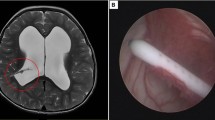Abstract
Background
Cerebrospinal fluid (CSF) shunts are life-long implants, and patients have reported anecdotally on noises associated with their shunts. There is, however, a marked lack of information regarding acoustic phenomena related to CSF shunts.
Methods
We identified all patients who had been treated or followed in our neurosurgical department within a 15-year period from January 2000 up to the end of 2014. After approval of the local ethics committee all patients who were cognitively intact were explored by a questionnaire and by personal interview about acoustic phenomena related to their shunts.
Results
Three hundred forty-seven patients were eligible for the survey, and 260 patients completed the questionnaire. Twenty-nine patients (11.2%) reported on noises raised by their shunts. All of them experienced short-lasting noises while changing body posture, mainly from a horizontal to an upright position, or while reclining the head. Most of the patients reported on soft sounds, but loud and even very loud noises occurred in some patients. Seventy-six percent of the patients were not bothered by these noises as they considered it as a normal part of the therapy or as proof that the shunt device was functioning. Modern valves with gravitational units are prone to produce noises in young adults, but nearly all valve types can evoke noises.
Conclusions
Noises caused by a shunt do occur in a considerable number of patients with shunts. One should be aware of this phenomenon, and these patients must be taken seriously.

Similar content being viewed by others
References
Flannery AMP, Mitchell L (2014) Pediatric hydrocephalus: systematic literature review and evidence-based guidelines. Part 1-10. J Neurosurg Pediatr 14(Suppl 1):3–81
Jensen F, Jensen FT (1979) Acquired hydrocephalus. I. A clinical analysis of 160 patients studied for hydrocephalus. Acta Neurochir 46(1–2):119–133
Koertke H, Hoffmann-Koch A, Boethig D, Minami K, Breymann T, El-Arousy M (2003) Does the noise of mechanical heart valve prostheses affect quality of life as measured by the SF-36 questionnaire? Eur J Cardiothorac Surg 24(1):52–57
Kolenda H, Schoener W (1995) Shunt-valve noise as an unusual reason for shunt revision. Childs Nerv Syst 11:489–491
Martines F, Sireci F, Cannizzaro E, Constanzo R, Martines E, Mucia M, Plescia F, Salvago P (2015) Clinical observations und risk factors for tinnitus in a Sicilian cohort. Eur Arch Otorhinolaryngol 272(10):2719–2729
Moritz A, Steinseifer U, Kobinia G, Neuwirth-Riedl K, Wolters H, Reul H (1992) Closing sounds and related complaints after heart valve replacement with St Jude Medical, Duromedics Edwards, Björk-Shiley Monostrut, and Carbomedics prostheses. Br Heart J 67(6):460–465
Nakano A, Tani E, Sato M, Shimizu Y (1994) Cerebrospinal fluid leakage from the nipple after ventriculoperitoneal shunt: case report. Surg Neurol 42(3):224–226
Ordia JI, Mortara RW, Spatz EL (1987) Audible cerebrospinal fluid flow through a ventriculoperitoneal shunt. Report of two cases. J Neurosurg 67(3):460–462
Stockhammer F, Miethke C, Knitter T, Rohde V, Sprung C (2014) Flow-related noise in patients with ventriculoperitoneal shunt using gravitational adjustable valves. Acta Neurochir 156:761–765
Tan LA, Kasliwal MK, Moftakhar R, Munoz LF (2014) Ventriculoperitoneal shunt with a rare twist: small-bowel ischemia and necrosis secondary to knotting of peritoneal catheter. J Neurosurg Pediatr 14(3):234–237
Author information
Authors and Affiliations
Corresponding author
Ethics declarations
Funding
No funding was received for this research.
Conflict of interest
All authors certify that they have no affiliations with or involvement in any organization or entity with any financial interest (such as honoraria; educational grants; participation in speakers’ bureaus; membership, employment, consultancies, stock ownership, or other equity interest; and expert testimony or patent-licensing arrangements), or non-financial interest (such as personal or professional relationships, affiliations, knowledge or beliefs) in the subject matter or materials discussed in this manuscript.
Ethical approval
All procedures performed in studies involving human participants were in accordance with the ethical standards of the institutional and/or national research committee and with the 1964 Helsinki Declaration and its later amendments or comparable ethical standards.
Informed consent
Informed consent was obtained from all individual participants included in the study.
Additional information
Comments
This is a relevant manuscript with the news that acoustic phenomena related to CSF shunt devices are more frequent than previously thought. Modern ball-in-cone valves with gravitational units in young adults are especially prone to evoking audible sounds. These noises are usually gentle and well tolerated by patients. Nevertheless, in their cohort of 29 patients with shunt valve noises, the authors found 57% of them were disturbed and 24% bothered by the noise. There is a clear demand for information from shunt patients to their neurosurgeons about this phenomenon.
Herbert Kolenda
Rotenburg, Germany
Rights and permissions
About this article
Cite this article
Kaestner, S., Fraij, A., Deinsberger, W. et al. I can hear my shunt—audible noises associated with CSF shunts in hydrocephalic patients. Acta Neurochir 159, 981–986 (2017). https://doi.org/10.1007/s00701-017-3179-z
Received:
Accepted:
Published:
Issue Date:
DOI: https://doi.org/10.1007/s00701-017-3179-z




